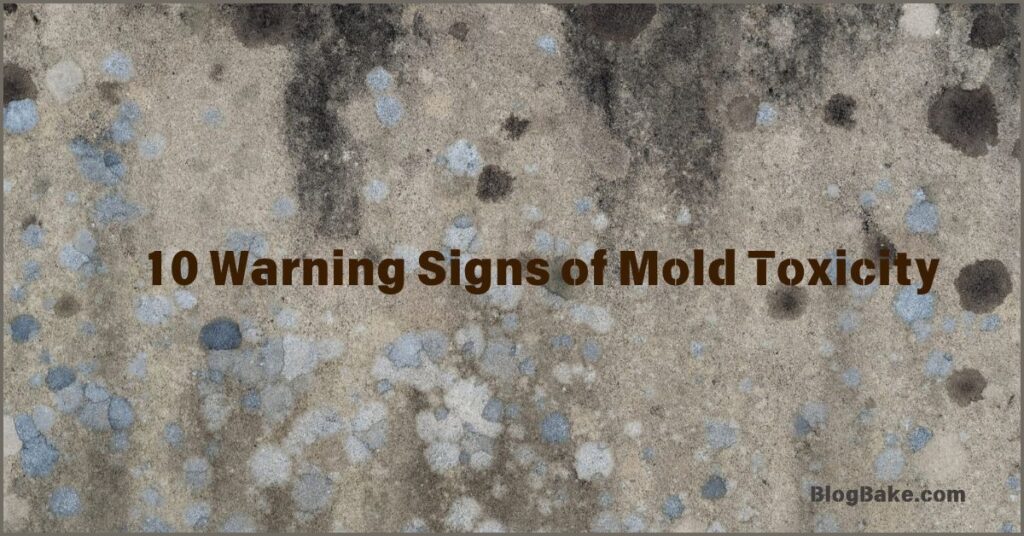When people are exposed to high concentrations of mold spores in their surroundings, they might develop mold toxicity, sometimes referred to as mold disease or mold exposure. Both indoors and outdoors, mold may grow and thrives in moist, humid environments. Although it is a normal component of the environment, some varieties of mold can release toxins that are extremely dangerous to human health. With 10 Warning Signs of Mold Toxicity, it’s critical to identify the early warning indicators of mold toxicity in order to save your family’s health as well as your own.
Introduction to Mold Toxicity
The harmful health effects resulting from exposure to mold and its derivatives, known as mycotoxins, are referred to as mold toxicity. When these chemicals are discharged into the atmosphere, they can contaminate indoor environments and cause a number of health issues.
Mold exposure can worsen pre-existing respiratory disorders, set off allergic reactions, and result in a variety of symptoms that impact the skin, mental system, respiratory system, and general health. It is important to know about 10 Warning Signs of Mold Toxicity.
Common Symptoms of Mold Toxicity
- Problems with Respiration
Shortness of breath, chest tightness, wheezing, and coughing are some of the symptoms that can result from mold exposure irritating the respiratory system. Moldy settings have the potential to exacerbate symptoms for people who suffer from asthma or other respiratory diseases. - Reactions to Allergens
In those who are vulnerable, mold spores can cause allergic reactions that manifest as symptoms including runny or congested noses, itchy or watery eyes, and irritation of the throat. Mold allergies are prevalent and can worsen pre-existing allergy symptoms. - Symptoms Related to Neurology
The neurological system may be impacted by mold toxicity, which may result in headaches, dizziness, memory issues, concentration issues, and cognitive decline. Extended exposure to mold toxins has been linked to mental problems and neurological illnesses. - Skin Problems
Skin irritation from mold or mold spores can cause rashes, itching, redness, and dermatitis. Skin issues brought on by mold exposure may be more common in people with sensitive skin or pre-existing skin disorders. - Weakness and Fatigue
Mold toxicity can result in malaise, weakness, and exhaustion, which can lower general energy levels and make it difficult to carry out everyday tasks. Even with enough rest and sleep, persistent weakness and exhaustion may endure. - Digestion Problems
Toxins from mold can be inhaled or consumed, irritating the digestive tract and causing symptoms like bloating, nausea, vomiting, diarrhea, and stomach discomfort. Continued exposure to mold-contaminated settings may exacerbate digestive problems.
10 Warning Signs of Mold Toxicity
- Prolonged Wheezing or Coughing
Recurrent coughing or wheezing that does not go better with traditional therapy could be a sign of respiratory problems associated to mold. - Sinus infections or congestion of the nose
Recurrent sinus infections, sinus pressure, and chronic nasal congestion could be indicators of respiratory system damage from mold exposure. - Migraines and Headaches
See a medical practitioner if you frequently get headaches or migraines that get worse when exposed to mold toxins or that happen in moldy settings. - Prolonged Fatigue
Fatigue, weakness, or lethargy that detracts from day-to-day activities and is not explained could be a sign of mold poisoning influencing energy levels. - Rashes or Skin Irritations
If you experience skin irritations, rashes, or allergic reactions in an environment where mold is present, you should look into the possibility of mold exposure further. - Deficit in Cognitive Abilities
Concentration issues, memory issues, brain fog, or cognitive impairment could be signs of mold toxicity’s neurological impacts. - Moods Swings or Depression
Mood fluctuations, agitation, nervousness, or despair that appear or intensify in moldy surroundings could be linked to mold poisoning having an impact on mental health. - Digestive Problems
When mold exposure is accompanied by digestive issues including nausea, vomiting, diarrhea, or abdominal discomfort, a medical expert should be consulted. - Muscle aches and joint pain
Inflammation, stiffness, aches in the muscles, and joint discomfort could all be signs of systemic inflammation brought on by mold toxins. - Sound and Light Sensitivity
Neurological symptoms connected to mold exposure may include increased sensitivity to light, sound, or other stimuli.
When to Seek Medical Attention
It is imperative that you seek medical attention from a professional for a diagnosis and examination if you exhibit any of the 10 Warning Signs of Mold Toxicity. To determine whether mold exposure is causing health problems, a complete medical history, physical examination, and diagnostic tests may be required.
Blood tests, urine tests, imaging investigations, and specialist assessments to identify mold toxins or assess organ function are some examples of diagnostic testing for mold toxicity. To find the causes of mold in a person’s house or place of employment, healthcare providers may also carry out environmental testing.
Preventing Mold Exposure
- Proper Air Circulation and Ventilation
Encourage adequate ventilation and air movement inside indoor areas to lower moisture content and stop the growth of mold. To enhance the quality of indoor air, use air purifiers, open windows when the weather permits, and install exhaust fans in bathrooms and kitchens. - Regular Maintenance and Cleaning
Maintain and clean indoor areas frequently to stop the growth of mold. Use mold-inhibiting cleaning agents, remove moldy objects, and clean and dry moist or damp areas right away. - Taking Care of Water Damage Quickly
Deal with floods, leaks, or water damage right away to stop the spread of mold. Fix leaks, dry out areas affected by water within 24 to 48 hours, and, if damage is severe, consider hiring a professional repair company. - Applying Humectants
To regulate interior humidity and lower air moisture content, use dehumidifiers. To prevent the growth of mold and provide a comfortable interior atmosphere, keep the relative humidity below 60%. - Materials and Products Resistant to Mold
When doing renovations and building projects, choose mold-resistant items and materials. Select flooring, insulation, paints, and sealants that are resistant to mold growth to reduce the possibility of mold growth in both residential and commercial structures.
Conclusion
It is crucial to identify the warning indicators of mold toxicity if you want to keep your health and wellbeing safe. If you suspect you may have been exposed to mold with 10 Warning Signs of Mold Toxicity, get medical help right once and take precautions to avoid getting exposed again. You and your family may create a safer and healthier indoor environment by being aware of the threats posed by mold and taking preventive action.
Read more About Health and Fitness!
FAQs
Can long-term health issues be caused by mold toxicity?
Long-term exposure to mold toxins can exacerbate long-term health conditions such immune system malfunction, neurological abnormalities, and respiratory troubles. It can be netter with 10 Warning Signs of Mold Toxicity.
How can I tell if mold toxicity is the source of my symptoms?
If you believe that your symptoms are being caused by mold exposure and you observe any of 10 Warning Signs of Mold Toxicity, get tested and evaluated by a medical specialist. Assays for allergies and blood can be used as diagnostic tools to find health problems linked to mold exposure.
Are certain people more prone to the damaging effects of mold?
Yes, people who already have allergies, weakened immune systems, respiratory disorders, or genetic predispositions may be more vulnerable to the negative health impacts of mold contact. Pregnant women, old people, and children can also be more vulnerable so they must be attentive to 10 Warning Signs of Mold Toxicity.
If I discover mold in my house, what should I do?
If you find mold in your house, get rid of it right once and deal with the underlying moisture problem. If there is significant contamination, consider contacting professional mold remediation services. When you see 10 Warning Signs of Mold Toxicity, clean and disinfect the affected areas. Wear the appropriate protective gear.
Can toxicity from mold be treated?
The goals of treating mold poisoning are to lower exposure, manage symptoms, and promote general health and wellbeing. for 10 Warning Signs of Mold Toxicity, this could involve taking prescription drugs, dietary supplements, changing one’s lifestyle, and cleaning up the surroundings.








1 thought on “10 Warning Signs of Mold Toxicity”